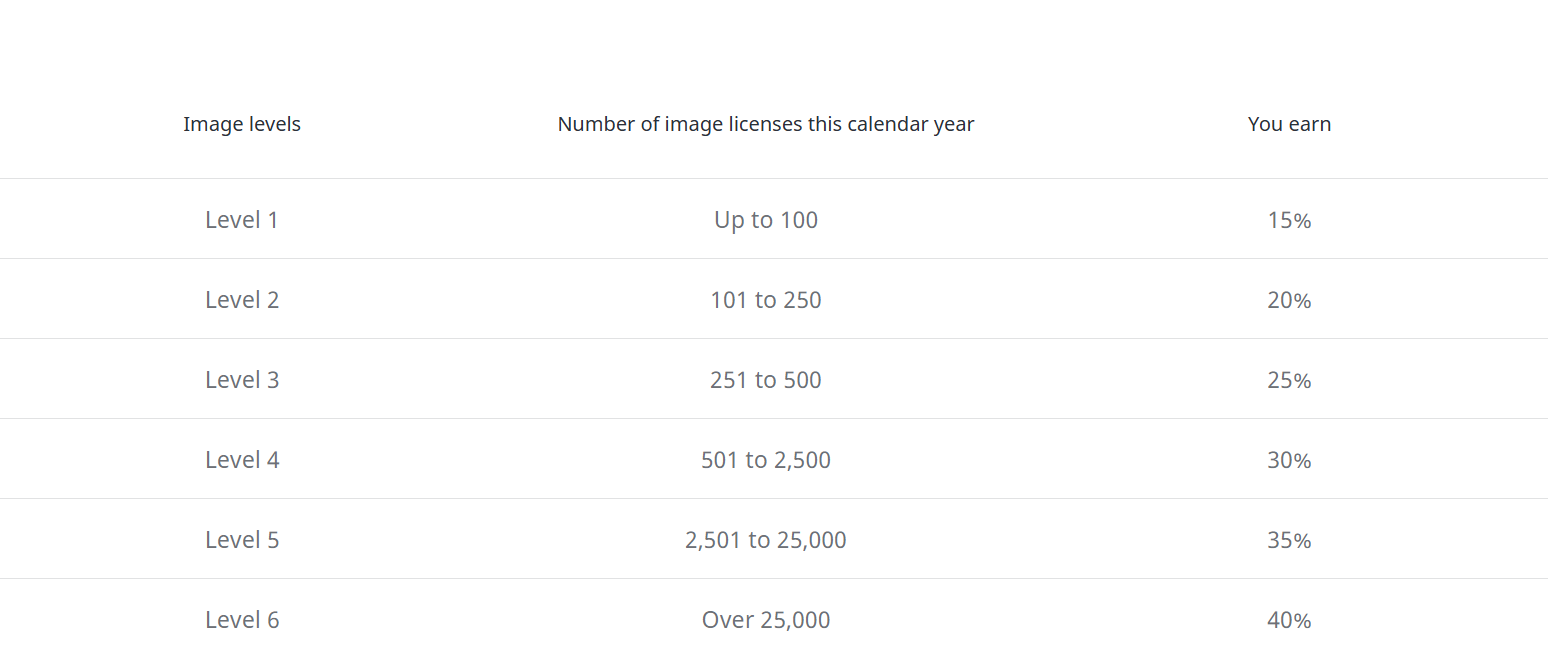If you’re a musician or composer looking to get your music heard and earn some income along the way, Shutterstock might just be the platform for you. Known primarily as a giant in stock photos and videos, Shutterstock also offers a robust music licensing program. It’s a fantastic way for artists to showcase their work to a global audience while earning royalties whenever someone licenses their tracks. The process is straightforward: upload your music, set your preferences, and wait for licensing opportunities to roll in. Whether you’re new to licensing or a seasoned pro, understanding how
Factors That Influence Earnings from Music Tracks on Shutterstock

When it comes to making money from your music on Shutterstock, several key factors can impact your overall earnings. Let’s break down what influences your income so you can better strategize your contributions and maximize your revenue:
- Type of License: Shutterstock offers different licensing options—Standard and Enhanced. Standard licenses are more affordable and typically generate lower royalties, while Enhanced licenses come at a higher price, resulting in higher payouts for the creator. Understanding which license your track is licensed under is crucial for estimating earnings.
- Track Popularity and Demand: Just like with any marketplace, trending or in-demand genres tend to earn more. Tracks that fit current trends—be it upbeat pop, relaxing ambient, or cinematic scores—are more likely to be licensed frequently, boosting your income.
- Quality and Production Value: High-quality recordings with clear sound, proper mixing, and mastering tend to perform better. Investors and licensees are more inclined to choose professionally produced tracks, which means investing in good production can pay off in royalties.
- Number of Uploads and Portfolio Size: The more tracks you upload, the higher your chances of licensing success. A diverse and extensive portfolio increases the likelihood that your music will be selected for different projects, thereby increasing your overall earnings.
- Geographic Licensing Trends: Shutterstock licenses music worldwide. Some regions may have higher demand for certain genres or styles, so understanding licensing trends in different markets can help you tailor your portfolio for maximum income.
- Pricing Strategy: Setting competitive yet fair prices for your tracks affects licensing frequency. While Shutterstock handles the pricing, understanding the typical licensing fees in your genre helps you gauge potential earnings and set goals.
In summary, your earnings depend on a mix of licensing types, track quality, market demand, and your overall contribution. By paying attention to these factors, you can make smarter decisions about what to upload and how to position your music for success on Shutterstock.
How Much Does Shutterstock Pay Creators for Music Tracks?
So, you’re curious about how much you can actually earn when you upload your music tracks to Shutterstock? Great question! Shutterstock’s payment structure for music is designed to reward creators based on various factors, including the type of license purchased, your contributor level, and the exclusivity of your content.
In general, Shutterstock offers two main licensing options for music tracks:
- Standard License – Suitable for personal, commercial, or promotional uses where the track is not being resold or embedded in a product that will be sold. The payout for a standard license typically ranges from $20 to $50 per track.
- Enhanced License – For uses that involve reselling, embedding in products for sale, or large-scale distribution. Enhanced licenses usually pay more, often around $50 to $200 or more per track, depending on the specifics of the use.
But wait, there’s more! Your earnings per track also depend on your contributor level. Shutterstock has a tiered system:
| Contributor Level | Qualification Criteria | Royalty Rate |
|---|---|---|
| New Contributor | First 3 months of contribution | 15% |
| Trusted Contributor | After earning $50 | 20% |
| Exclusive Contributor | Exclusive rights to your music | 25% |
To give you a rough idea, if you upload a track and it’s licensed under a standard license, you might earn around $5 to $12 as a non-exclusive contributor. If your track gets an enhanced license, your earnings could jump to $25 or more. Keep in mind, Shutterstock’s payout is based on the net amount after they take their cut, so your actual earnings depend on licensing volume and your contributor status.
It’s also worth noting that Shutterstock sometimes offers bonuses or promotional payouts for top-performing tracks, so staying active and uploading high-quality music can really pay off!
Tips to Maximize Your Earnings as a Music Contributor on Shutterstock
If you want to boost your income as a music contributor, a few smart strategies can make a big difference. Here are some tried-and-true tips:
- Create High-Quality, Versatile Tracks – Focus on producing professional, well-mixed music that can fit a variety of projects. Tracks that are generic enough to be used in multiple contexts tend to get licensed more often.
- Understand Market Trends – Keep an eye on what types of music are in demand. For example, cinematic, corporate, and ambient tracks are often popular for videos and commercials. Tailoring your production to current trends can increase your chances of licensing.
- Use Descriptive Keywords and Titles – Proper tagging helps your tracks get discovered. Use relevant keywords that describe the mood, genre, instruments, and potential uses of your music.
- Upload Consistently – The more quality tracks you add, the higher your chances of earning. Regular uploads keep your portfolio fresh and increase your visibility on the platform.
- Leverage Exclusivity Wisely – While exclusive tracks can earn higher royalties, they limit your reach to Shutterstock alone. Weigh the benefits of exclusivity versus broader licensing opportunities based on your goals.
- Engage with the Community – Participate in forums, read contributor guides, and stay updated on platform policies. Learning from other successful contributors can provide insights that help you optimize your strategy.
- Monitor Your Performance – Use Shutterstock’s analytics tools to see which tracks are licensing most often. Focus on creating more content in those genres or styles.
Remember, patience and persistence are key. Building a solid portfolio and understanding what buyers are looking for can turn your musical talents into a steady income stream. Keep refining your craft, stay informed about platform updates, and don’t be afraid to experiment with different styles and genres. Happy creating!
How to Upload and Submit Music Tracks to Shutterstock
Getting your music tracks onto Shutterstock is a straightforward process, but it’s important to follow each step carefully to make sure your submissions are successful. Whether you’re a seasoned musician or just starting out, here’s a simple guide to help you navigate the upload process.
Step 1: Create a Contributor Account
First things first, you’ll need to sign up as a contributor on Shutterstock. Head over to their website and fill out the registration form. Once approved, you’ll gain access to your contributor dashboard where all the magic begins.
Step 2: Prepare Your Music Files
- Ensure your tracks are in the accepted formats (usually WAV or MP3).
- Check the quality—Shutterstock prefers high-quality, professional-sounding tracks.
- Fill in metadata: Title, artist name, genre, mood, and keywords. Being descriptive helps your track get discovered.
Step 3: Upload Your Tracks
In your dashboard, look for the upload button. You can drag and drop your files or browse your folders to select them. Make sure each file is correctly labeled to match your metadata.
Step 4: Add Metadata and Tags
This is a crucial step! Use relevant keywords and descriptive tags to make your music easily searchable. Think about what a buyer might search for—genres, instruments, emotions, or specific uses.
Step 5: Submit for Review
Once everything is uploaded and filled out, click the submit button. Shutterstock’s review team will then evaluate your track for quality, originality, and compliance with their guidelines. This process usually takes a few days.
Step 6: Await Approval and Promotion
If your track passes review, it will go live on the platform. Now, it’s just a matter of promoting your portfolio and waiting for sales to come in. Remember, the more quality tracks you upload, the better your chances of earning!
And that’s it! Uploading music to Shutterstock is pretty straightforward once you get the hang of the process. Keep your files professional, your metadata accurate, and stay consistent with your uploads. Before you know it, your music could be earning you royalties!
Frequently Asked Questions About Shutterstock Payments for Music
Many contributors have questions about how payments work on Shutterstock, especially when it comes to music tracks. Let’s clear up some of the most common queries so you can feel confident about your earnings.
Q1: How much does Shutterstock pay for music tracks?
The payout rate varies depending on your contributor level and the type of license purchased. Typically, contributors earn between 20% to 30% of the sale price for each music track. The exact amount depends on your exclusivity status and the licensing model selected by the buyer.
Q2: How are royalties calculated?
Royalties are calculated based on the licensing type:
- Standard License: Usually lower payout, suitable for most uses.
- Enhanced License: Higher payout, used for larger projects or more extensive use.
The final payout depends on the license type, the sale price, and your contributor level.
Q3: When do I get paid?
Shutterstock typically processes payments on a monthly basis. You need to reach the minimum payout threshold (usually $35) before they send you a payout. Payments are made via PayPal, Payoneer, or bank transfer, depending on your selected method.
Q4: Are there any fees or deductions?
Shutterstock does not deduct fees from your royalties. However, keep in mind that currency conversion fees may apply if your payout is in a different currency. Always check the latest payout policies for detailed information.
Q5: Can I see how much I’ve earned?
Yes! Your contributor dashboard provides detailed reports showing your earnings, sales, and which tracks are performing best. Regularly checking these stats can help you understand what kinds of tracks are in demand.
Q6: Do I have to pay taxes on my earnings?
Tax obligations depend on your country of residence. It’s recommended to consult with a tax professional to ensure you’re complying with local laws regarding income from stock music sales.
Hopefully, this FAQ clears up some of your questions about Shutterstock payments. Remember, building a consistent portfolio and understanding how licensing works are key to maximizing your earnings. Keep creating and uploading—your music has the potential to reach a global audience!
Conclusion and Final Tips for Music Track Contributors
In summary, understanding Shutterstock’s payment rates for music tracks is essential for maximizing your earnings and building a successful contribution portfolio. While rates can vary based on factors such as license type, exclusivity, and usage, being aware of these variables helps you set realistic expectations and strategize effectively. Remember, consistently producing high-quality, original music increases your chances of earning more and gaining long-term recognition within the platform.
Here are some final tips to enhance your success as a music contributor:
- Focus on Quality: Ensure your tracks are well-produced, clear, and professionally mastered to attract buyers and increase sales.
- Stay Updated: Keep abreast of Shutterstock’s latest policies, rate changes, and trending genres to tailor your submissions accordingly.
- Optimize Metadata: Use relevant keywords, accurate descriptions, and appropriate categories to improve discoverability.
- Diversify Your Portfolio: Offer a variety of styles and moods to appeal to a broader audience and maximize earning potential.
- Engage with the Community: Participate in forums or groups to learn tips, share experiences, and stay motivated.
Ultimately, patience and persistence are key. By understanding the payment structure and implementing these best practices, you can steadily grow your presence on Shutterstock and turn your music into a reliable income stream.

